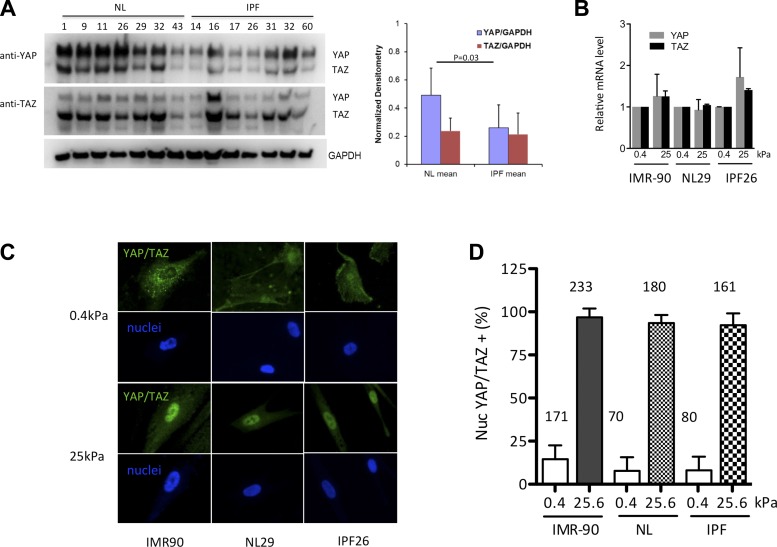Fig. 2.
YAP and TAZ respond to pathophysiological increases in matrix stiffness by relocalizing to fibroblast nuclei. A: despite immunohistochemical evidence for enhanced YAP/TAZ expression in IPF, IPF-derived fibroblasts do not overexpress YAP/TAZ in a cell-autonomous fashion. Cells from 7 different normal and IPF lungs were grown on tissue culture plastic, and YAP/TAZ protein levels were analyzed by Western blotting with mouse anti-YAP (63.7) antibody (Santa Cruz Biotechnology) and rabbit anti-YAP/TAZ (D24E4) antibody (Cell Signaling). Both antibodies cross react with YAP and TAZ, which appear at molecular weights of ∼70 kDa and ∼55 kDa, respectively. GAPDH was used as a loading control. Densitometry normalized to GAPDH demonstrates a modest decrease in YAP protein levels in IPF fibroblasts relative to normal lung fibroblasts. NL, normal cells. B: YAP and TAZ transcript levels vary little across matrix stiffness conditions spanning the pathophysiological range in IPF-derived, normal, and IMR-90 fibroblasts (n = 3 independent experiments). C: in contrast, YAP and TAZ nuclear localization is dramatically altered by matrix stiffness. Immunostaining with mouse anti-YAP (63.7) antibody (Santa Cruz Biotechnology, detects both YAP and TAZ) and Hoechst 33342 after culturing 48 h on 0.4- and 25.0-kPa shear moduli polyacrylamide hydrogels demonstrates pronounced nuclear localization on stiff matrices. D: cells with predominantly nuclear YAP/TAZ localization were counted in a blinded fashion on 0.4- and 25.0-kPa gels and expressed as a fraction of total cell number. N = total number of cells analyzed from 2 independent experiments from 3 normal (NL29, NL43, and NL45) and 3 IPF (IPF14, IPF26, and IPF32) lines.

